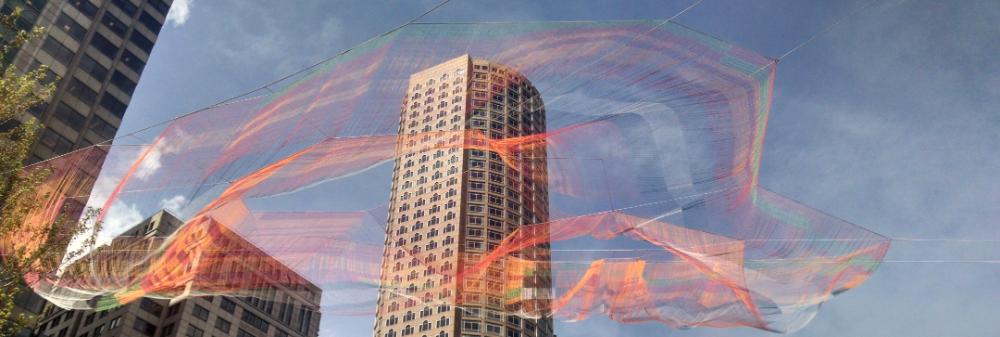
Im/material Event #1: Place and Performance
Virtual Encounters with Material Worlds: Glasgow, 15 April 2019
|
|
A Summary of Event #1
What happens when we introduce immersive technologies that add a new set of immaterial cues to public spaces? How do individual digital experiences, AR or XR experiences in public spaces affect interactions that have developed assuming a shared place-based context? Can immersive technologies and experiences be used to affect positive changes in public interactions? How might immersive experiences help us to understand social and performative uses of built spaces?
Virtual and Augmented Reality technologies are quickly changing and becoming more integral to practice across a range of creative, design and academic disciplines. The Im/material network was developed to explore the impact of these new media on the way we work.
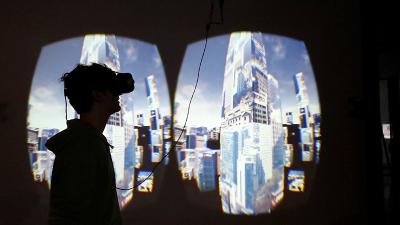
During the first im/material event in Glasgow, Stuart Jeffrey (Glasgow School of Art), Malath Abbas (Biome Collective), and Catherine Clarke (School of Advanced Study, University of London) discussed the impact that Augmented reality and Virtual reality (AR/VR) technologies can have on public places. The panel members agreed that a place is not only defined by its tangible buildings and structures, but also its intangible features: the meaning-making activities of the people within that place, the cultures and traditions of those people, or the things that have happened in that space, whether a significant historical event that defined a national narrative or an individual’s personal memory of a single moment. There were several ideas and themes that recurred throughout the discussion around AR/VR and place, which are summarised below.
Can VR/AR be a shared experience?
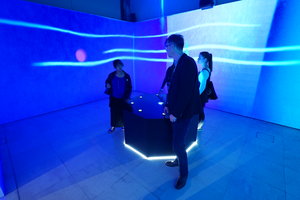
It was noted early on in the discussion that the commercial drive currently behind VR/AR is geared towards an individual’s visual experiences, primarily through a headset, which can be quite isolating. However, Malath pointed out that it is possible to provide an immersive experience that is focused more on the shared experience and does not have to be overly high-tech. He gave an example of an installation where they projected the digital environment onto the walls of a room, with which participants were then able to interact as a group within the space. Overall, the panellists agreed that the approach should be kept simple and effective.
How can VR/AR enhance one's experience of a place?
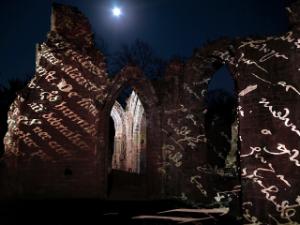
VR/AR techniques enable a more complex interpretation of a place, as they allow for multiple perspectives to be told about an event or place. A single ‘master narrative’ of a place should be avoided. One of the primary benefits of AR and VR identified by the panel members is that the technology allows for different types of information to overlay places and enrich the users’ experience of the place. Catherine argued that these techniques enable a more complex interpretation of a place, as they allow for multiple perspectives to be told about an event or place. A single ‘master narrative’ of a place should be avoided. She also emphasised how important creating the opportunity for a chance encounter or unexpected occurrence within a VR/AR activity is, because serendipitous occurrences are an important factor in creating connections with a ‘place’.
Can VR allow us to add to the place?
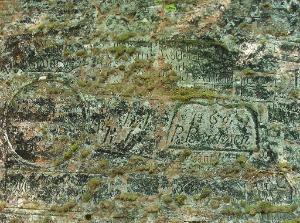
Another integral part of making connections with and experiencing a place is making one’s mark in some way; in the material world, especially at popular tourist sites, this can often take the form of graffiti. Stuart stated that this type of interaction with a place demonstrates part of the difficulty of VR/AR: there is an underlying anxiety about the inherent impermanence and immateriality of these digital spaces. In the digital realm, there are limitations in how much users can interact with the place and make their mark – in fact, in some cases of corporate abandonment (eg. Geocities, SecondLife), the entire digital space can cease to exist. Stuart argued that practitioners should be clear about this, and that VR/AR experiences should be cast as performative and transient from the outset.
If it is up to us to decide how AR will make an impact, what practices can we put into place?
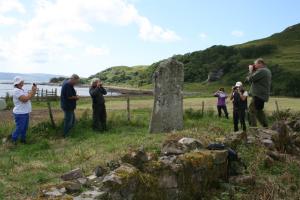
One final point that all of the panel members collectively agreed upon was the need for more co-design and co-production in VR/AR projects. By engaging with the public, including the local community in producing content, and incorporating input and feedback from a broad spectrum of people, not only is the resulting product more meaningful and effective, but the process leading to its production also becomes more significant.
Where can we go with AR/VR, looking forward?
While there are drawbacks that need to be considered and combatted, as there always are with public and digital spaces, the panel was optimistic. VR/AR technology provides an interdisciplinary centre of gravity around which one can experience the different practices of collaborators from different disciplines and perspectives. These immersive techniques provide a new way to engage with place and to tell a diverse range of stories. To end this summary, I’d like to share one of my favourite quotes from Malath that I feel encapsulates the spirit of the event: ‘Make cool stuff with cool people in the broadest sense possible'.
*Events in the 'Virtual encounters with material Worlds' conversations series will be recorded. Recordings will be posted online shortly after each event.
Thoughts from our Speakers:
The commercial drive currently behind VR/AR is geared towards an individual’s visual experiences, primarily through a headset, which can be isolating. - Malath Abbas
These techniques enable a more complex interpretation of a place, as they allow for multiple perspectives to be told about an event or place. A single ‘master narrative’ of a place should be avoided. -Catherine Clarke
There is an underlying anxiety about the inherent impermanence and immateriality of these digital spaces. In the digital realm, there are limitations in how much users can interact with the place and make their mark. - Stuart Jeffrey
By including the local community in producing content, not only is the resulting product more meaningful and effective, but the process leading to its production also becomes more significant. - Stuart Jeffrey
VR/AR technology provides an interdisciplinary centre of gravity around which one can experience the different practices of collaborators from different disciplines and perspectives. - Gareth Beale
Immaterial Event #1: Place and Performance Recording
Projects noted in Discussion
Event #1, April 15 2019
Several published works and projects were mentioned during the discussion; citations and links are provided below for more information.
Certeau, Michel de. 1984. The Practice of Everyday Life, trans. S. F. Rendall. University of California Press, Berkeley, CA.
Jeffrey, Stuart. 2012. A new Digital Dark Age? Collaborative web tools, social media and long-term preservation. World Archaeology 44(4): p.553–570.
Malath’s VR Game, ‘Garden’: http://www.malathabbas.com/garden
Catherine’s work on Medieval Swansea: http://www.medievalswansea.ac.uk/en/
Malath’s Location-Based Alternate Reality Sound Game, ‘Other’ - http://www.malathabbas.com/page
Nicky Bird’s (GSA) work with West Calder: https://nickybird.com/projects/heritage-site-2014-2016/
The immersive experience created at the Battle of Bannockburn: https://battleofbannockburn.com/
Scotland’s Rock Art Project: https://www.rockart.scot/
On the creation of experiences: https://www.splashandripple.com/about/
Within the Walls of York Gaol, Gareth Beale (University of Glasgow): https://gtr.ukri.org/projects?ref=AH%2FR008701%2F1
Contested Memories – Battle of Mount Street Bridge: https://mountstreet1916.ie/
The Emotive Project: https://emotiveproject.eu/
Stuart’s work on the Isle of Staffa: http://gsapress.blogspot.com/2016/08/historic-visitors-to-staffa-set-to-be.html
The London Charter for the Computer-Based Visualisation of Cultural Heritage (Draft 2.1): www.londoncharter.org
Reflections from our Speakers
Catherine Clarke
It was a privilege to be involved in this lively, inclusive and supportive discussion on Augmented Reality in the context of ‘Place and Performance’. As with all of us involved in the conversation, I brought my own particular background, experiences and research interests to the topic – in my case, as a cultural historian and medievalist, with experience of leading projects based on historic places and their interpretation today, often including digital methods and elements of AR. (See for example www.medievalswansea.ac.uk, www.thomasway.ac.uk or discover.medievalchester.ac.uk).
We were all struck by the level of agreement in the conversation around challenges for bringing AR to the interpretation and representation of place, as well as opportunities and future goals. As panellists, Mal, Stuart and I all shared a strong sense of positivity and optimism about the future of AR in this context – as well as some cautions and concerns.
Our discussion began with Rachel’s question ‘What makes a place?’. My own answer started with some theory – Michel de Certeau’s view of New York from the top of the World Trade Center Towers, as recounted in his book The Practice of Everyday Life. Looking down from the Tower, de Certeau enjoys the fantasy of a perfectly legible city laid out below him – an ‘erotics of knowledge’ – but then goes on to unpick this illusion. Places are really made, he argues, by the meaning-making activities of the ‘ordinary spatial practitioners’ down in the streets below. For me, a real challenge of bringing AR to place is not to reproduce or reify those seductive (and/or dangerous) ‘master’ narratives, dominant narratives or official versions of place, but to draw in and represent the diverse experiences, stories and memories of individuals and communities. AR offers us powerful opportunities to examine lines of exclusion, and to surface marginalised or invisible stories in place. I really enjoyed Gareth Beale’s contribution, from the audience, on a recent project in York Gaol, which sought to do exactly this.
Several threads ran strongly through our conversation. We agreed on the limitations of screen-based technology, on the dominance of the visual as a mode of engaging with and knowing place, and on the tyranny of the headset or absolute immersion in VR. We all looked to opportunities for creating shared experiences through AR, whether through games and play, or through interventions in places rather than then necessarily discrete curated individual experiences. As a medievalist, I looked back to pre-digital modes of AR for inspiration – whether the way that stained glass transforms a medieval cathedral, or the capacity of story-telling to transport participants and transform place. These precedents, together with non-digital forms of AR today, can help to extend and nuance our sense of what could be possible or desirable, and are often predicated on far more shared, communal experiences.
We were all keen to see AR in place as something extensible and organic which could be augmented by the traces left by participants – I recalled the post-medieval graffiti I’d enjoyed the previous week on a trip to Kenilworth Castle. We discussed the importance of finding ways to facilitate the unpredictability of being in a place: serendipity, chance and unreplicability, and the hope that AR could become a ‘found’ or discovered experience which didn’t necessarily need prior preparation or knowledge. We were all excited by play, playfulness, surprise and absurdity. In terms of connecting places and histories, we saw AR at an exciting liminal point between factual history and counter-narratives, speculative histories or fictions, allowing us to think in more experimental ways about our relationships to the past in place. Fundamentally, we all saw AR as a supremely collaborative field, benefiting from multiple disciplinary perspectives, and skillsets, and giving academics the opportunity to work, think and engage in new ways, through different forms of content.
While we were engaged in our discussion, the Cathedral of Notre Dame, Paris, was burning. I only discovered this later that night, back at my hotel, when I turned to my phone screen. What could have been a more timely context for our discussion of AR and its capacity to intervene in places and their histories, at loci of absence, loss and invisibility, or sites with diverse meanings for multiple individuals and communities? Our conversation was more acutely relevant, and poignant, than any of us realised.
Catherine Clarke
Chair in the History of People, Place and Community, Institute of Historical Research, University of London
Stuart Jeffrey
The discussion was wide ranging and, speaking as a panellist, I found it really insightful and informative, hopefully the audience felt the same. The slightly differing perspectives from each domain, heritage, history and gaming, to the key questions was really fascinating. While there was a range of approaches to understanding places and place making expressed, It was also gratifying that there was so much agreement between the panellists, particularly regarding the importance of creative response and the benefits of embracing the ‘messiness’ of the past, as well as considering the digital as part of a suite of ways of engaging, that can be used together, mixing the digital and the physical.
The whole conversation felt well-structured and expertly guided by Rachel, we each got the opportunity to consider both the more abstract and philosophical questions around the definitions of place and place making as well as the practical implications that this has, particularly in relation to digital heritage and the immaterial nature of the digital outputs. It is always a good sign that the conversation is fruitful when it feels that it was over too soon. We touched upon a couple of topics that I think we will have to look for future opportunities to discuss, in particular the concept of digital places themselves (shared online social spaces), how they operate and who controls them, as this is likely to present some interesting conundrums for heritage practitioners in the next few years.
Stuart Jeffrey
Reader in Heritage Visualisation at the School of Simulation and Visualisation, The Glasgow School of Art


